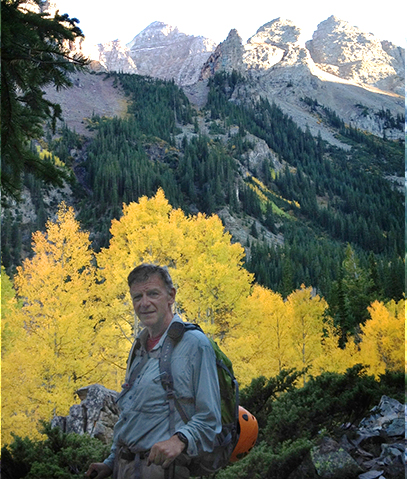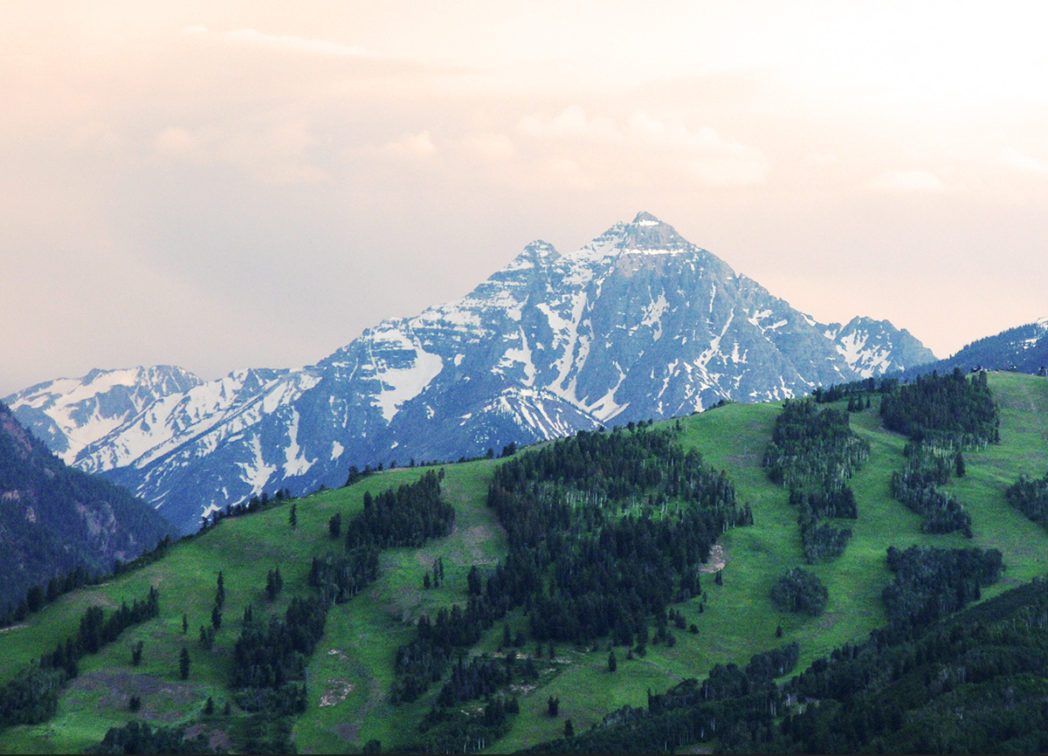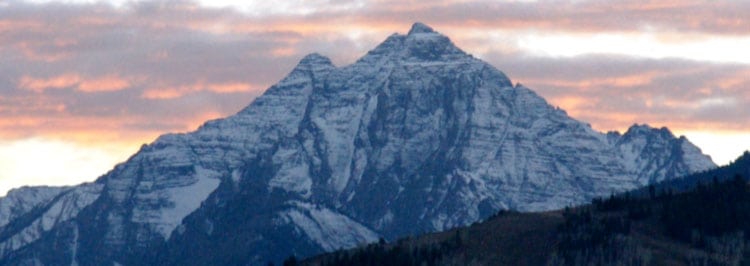
Difficulty: Class 4
Exposure: Serious
Summit: 14,018 feet
Elevation Gain: 4,550 feet
Roundtrip: 8.00 miles
Trailhead: Maroon Lake at 9,600’
Climbers: Rick Crandall; Andy Mishmash; Jeff Hall; Andrew Beuter September 15, 2012
Pyramid Peak is one of the Maroon Bells fourteeners that are part of the Elk Range near Aspen.
I stare at this peak every day I’m in Aspen because our home in Aspen was designed by Charles Cunniffe Architects to frame Pyramid, a fact that was picked up in a cover story by Mountain Homestyle Magazine
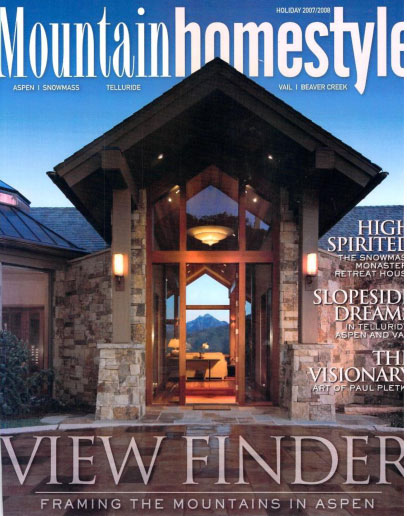
With front door open, see Pyramid Peak clear through the living room window – note all the roof angles mirror Pyramid’s angles.
See: https://www.rickcrandall.net/wp-content/uploads/pdf/22%20Mountain%20Living%20Magazine.pdf
Many of the unusual woods used on interior features were built by friend, master Class 5++ climber and master craftsman, Andy Mishmash. Andy has been offering for several years to take me at least part way up Pyramid – to a saddle at 12,800’ from which I can see our house. Cool idea, but I’ve always had my doubts if I had the ability to do the climb – even that far up.
Why? See a variety of descriptions from a whole bunch of sources.
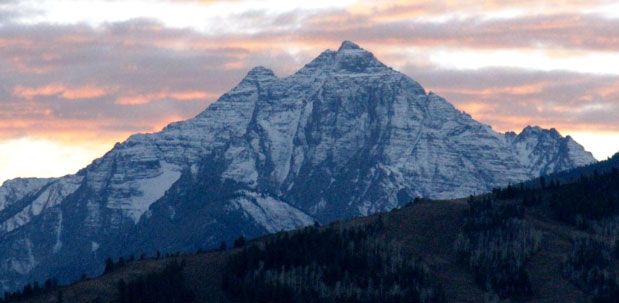
Telephoto view of Pyramid Peak’s North Face from our deck
Roach’s classic guide: Colorado’s Fourteeners: “Like the Maroon Bells, … steep, exposed loose rock … the potential falls from this route’s upper 1000 feet are almost all fatal drops. Pyramid has one of Colorado’s most rewarding summits. When you are on the ridge crest, take time to peer west across Pyramid’s imposing north face.
Take great care with your movement and route finding. If you find yourself faced with a Class 5 section, retreat and try another route.”
14ers.com: “Typical of peaks in the Elk Range, Pyramid Peak is composed of loose rock and should be approached with caution.”
Fourteeners Initiative: “Pyramid is one of the most challenging Fourteeners. Make sure you have knowledge and experience before climbing this peak.”
SummitPost.com: “This route could very well be the steepest sustained route you have ever encountered on a mountain. The route from the trailhead to the 12,800’ saddle is relentlessly steep. The last 1000’ is continuous tough Class 3 and Class 4 climbing. In just under 4 miles you’ll get to gain 4550’ in elevation, so be prepared for some serious climbing! The geology falls into the crumbling, sedimentary category. All 14,018’ of this magnificent mountain can be described by the three R’s: red, rugged and rotten.”
Unlike other mountains in Colorado, the Maroons are composed of metamorphic sedimentary mudstone that has hardened into rock over millions of years. This mudstone is weak and fractures readily giving rise to loose rock. You can see what I mean when you look at the rock in the “amphitheater” later in this story.
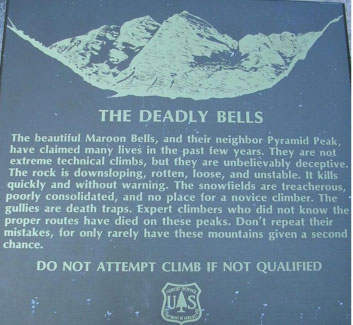
Then there’s this sign that greets you at Maroon Lake.
Well if you read reports from accomplished climbers, they do well on this mountain so I figure most of these warnings are for hikers and Class 2 and 3 climbers.
Anyway, I’d had a great summer climbing 7 fourteeners while ducking and weaving around constant thunderstorms almost daily and many days of smoke in the air from a record number of western states forest fires. So I was feeling fit and a bit down that the summer was gone and winter skiing was still a few months off.
Then Andy called – “Weather looks good, want to take a try at Pyramid this Saturday?”
It took me about a nanosecond to accept – he’s the only person I know who I’d trust totally with such an attempt, e.g. see the Wetterhorn climb with him at https://www.rickcrandall.net/wetterhorn-peak-a-class-3-4-adventure-with-andy-mishmash/ or the Little Bear Peak adventure at https://www.rickcrandall.net/little-bear-peak-in-a-snowstorm-and-a-real-bear/. He invited his two friends along, Andrew and Jeff – both more adept and faster than me, which concerned me, but Andy said – “no worries, I told them it was going to be a 14 hour day if we decide to go to summit.” You won’t see many photos of Andrew and Jeff because they were always way ahead of us and getting into Jeff’s camera is not easy!
Fourteen hours on a Class 4 mountain? I don’t think so, but I knew I could turn around at any time and Andy would stick with me.
So, at 3:45 am Saturday morning I was up eating bacon and eggs (bulk up on protein) and met them at Maroon Lake in the dark at 5 am and we headed up to Crater Lake where the trail cut-off is to Pyramid.
The nice thing about hiking in the dark with headlamps is that somehow you don’t notice the elevation gain. We got up the 500’ and 1 ½ miles but it was so dark we missed the cairn to the trail. For some reason it gets knocked down regularly, so we backtracked and found it and off we went.
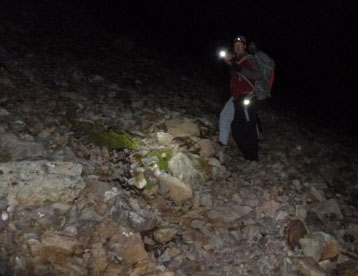
Andy looking for the cairn.
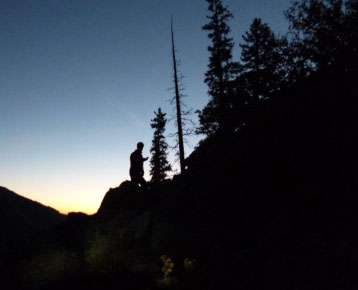
The next leg of this adventure was a 1000’ elevation gain from trailhead to the beginning of what is called the amphitheater. This trail had been improved by the Colorado Fourteeners Initiative in 2006 which made for a much better start (and finish) to the day. It was still 1000’ up, but mostly in the dark so not much impact on the quads yet.
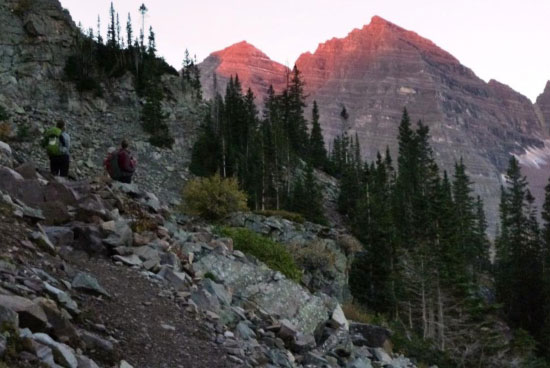
Then the alpenglow – indirect sunlight glowing red on the mountaintops as Jeff and Andrew neared the tree line.
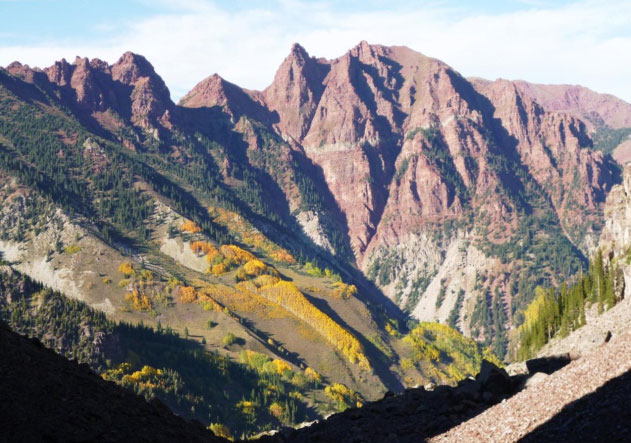
We got to the beginning of the amphitheater as the sun showed us first glimpse of the color we were going to see all day– Aspen trees turning flaming yellow two weeks earlier than the normal season – just for us!
Looking up the amphitheater, we saw the sun lighting the peak of Pyramid. There is no effective photograph that can express how impressive is this basin. The amphitheater is a huge basin ending in a visible glacier, but with much of the glacier hidden under an unquantifiable amount of fallen rocks – literally from the surrounding mountains falling apart. These rocks are sharp – mud-rock cleaved from the effects of water freezing and thawing and cascading down the mountains. We heard the rock slides as we hopped from rock to rock – through and up the entire length of this ¼ mile wide and nearly 1 mile long incredible feat of nature.
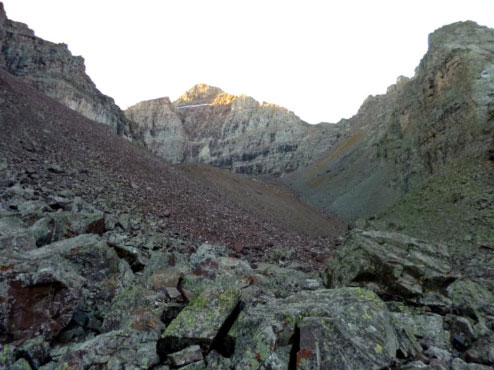
There was no real path through this field; as Jeff came up alongside me, I asked: “which way?” To which he quipped: “Up, in this climbing thing you go up!” Big help, so I followed him.
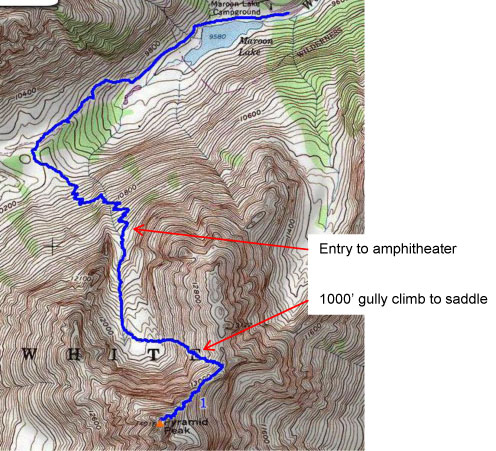
We boulder-hopped nearly to the end of the amphitheater and then headed off left to the base of a loose, steep gully that we next needed to grind up another 1000’ of elevation gain to a saddle.
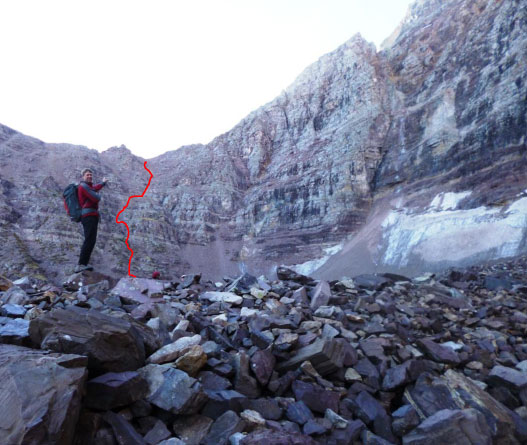
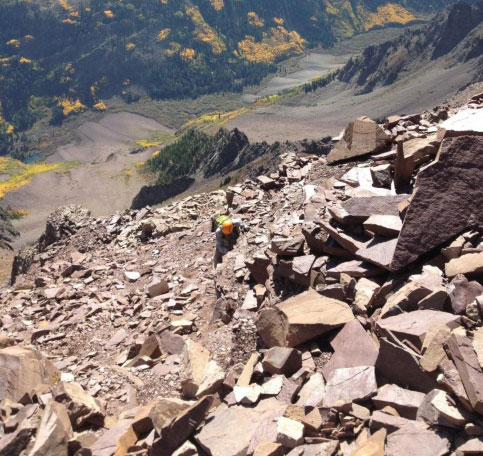
Rick trekking up the loose gully with the valley floor already over 2500’ below.
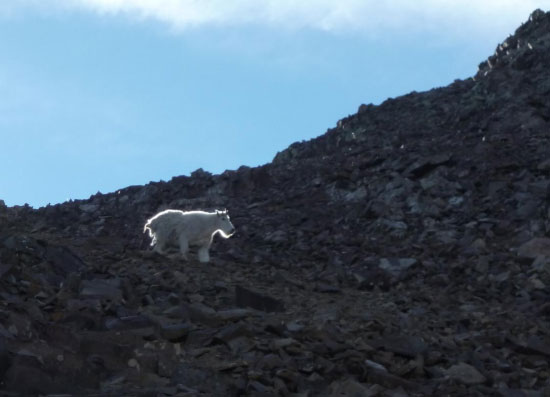
As I looked up the gully, I saw movement – and then the first of several mountain goat encounters – this one beautifully backlit. They’re not aggressive, and they are incredible mountain climbers as you’ll see.
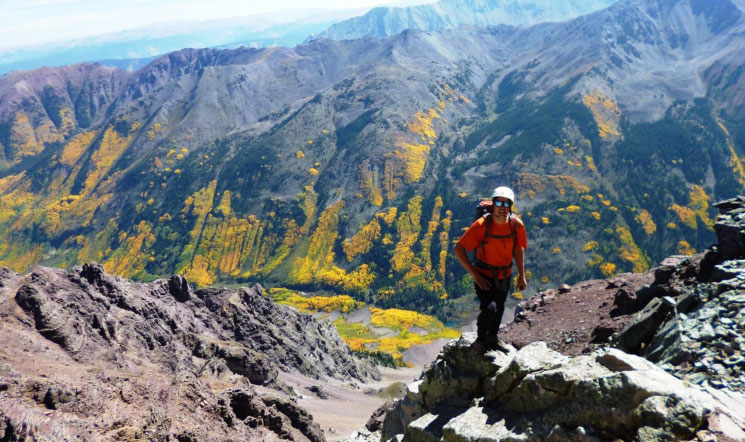
Andy topping the gully – just look at those colors!
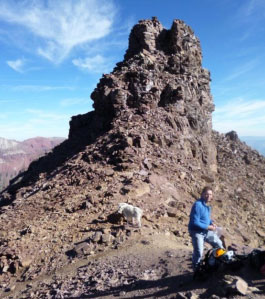
Jeff at the 12,800’saddle first
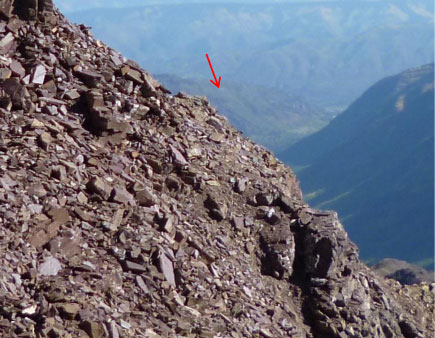
As Andy and I got to the saddle, it was the first time we could see north – and he pointed out where my house was. He declared:“Well, I’ve met my objective – I wanted to get you up far enough to see your house, now what?” Well I was feeling good so I figured we should take a closer look at what’s involved in summitting. When I turned around, I saw Pyramid – without the benefit of the informative blue and red lines:
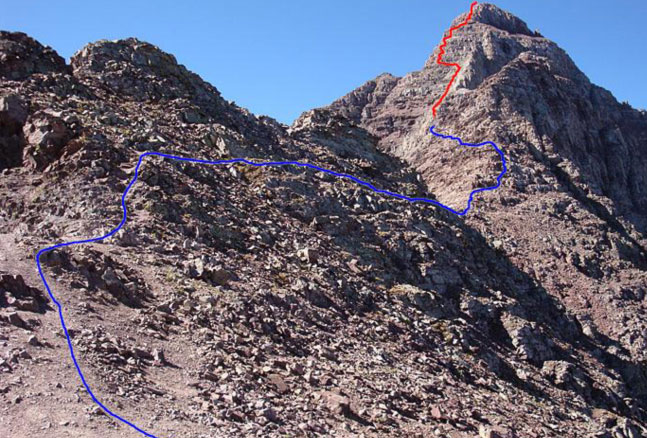
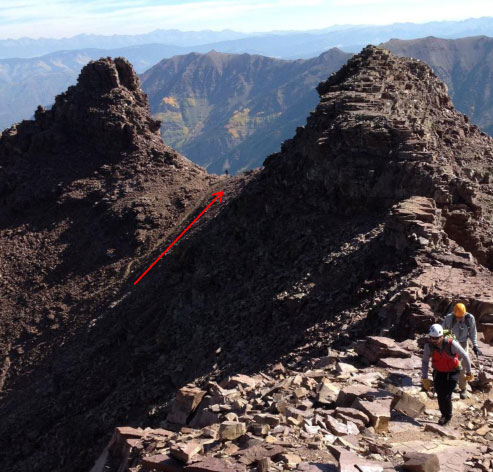
Helmets donned, Andy (white) and Rick (orange) heading up the 200’ to the “ledges,” our next objective. The arrow is the 1000’ gully we’d just ascended.
The goats. Can it be? We saw goats all the way up to summit!
Their climbing abilities are amazing and we saw a young goat with similar no fear. So I looked them up – they have a double coat that can withstand temps to -50 F and winds up to 100 mph. Their feet are well-suited for climbing steep, rocky slopes, sometimes with pitches of 60 degrees or more, with inner pads that provide traction and cloven hooves that can be spread apart as needed. Also, the tips of their feet have dewclaws that are sharp to keep them from slipping. Throughout the year they usually stay at or above tree line. Mountain goats are herbivores and spend most of their time grazing. Their diet includes grasses, herbs, sedges, moss, twigs and leaves from the low-growing shrubs and conifers at tree line.
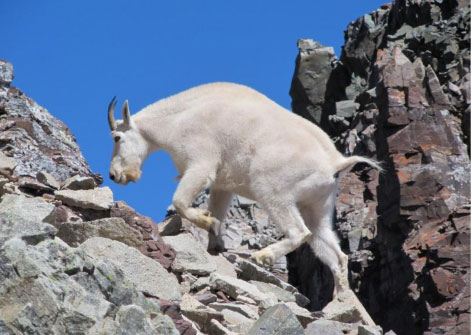
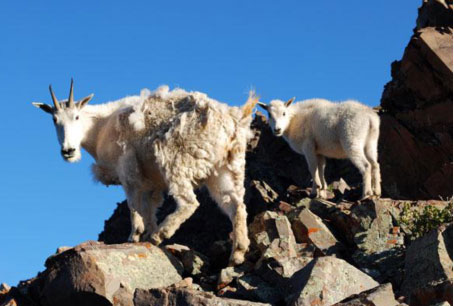
Mom still shedding and baby. No fear!
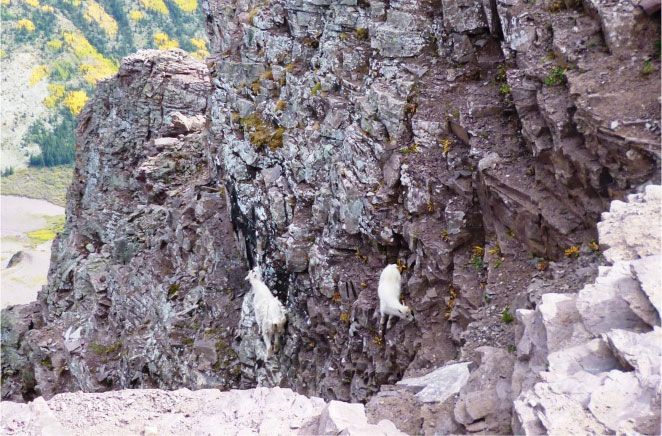
We were on our way to the ledges. They had a friendly start … and then they kept getting narrower … with exposure.
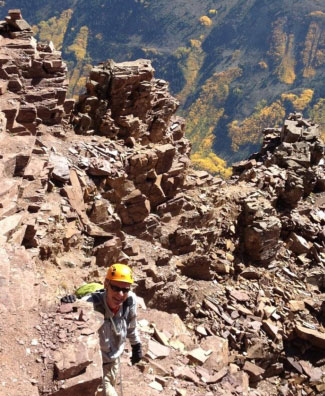
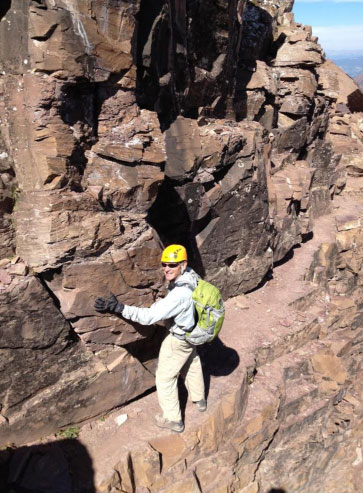
Narrowing ledges with rock that is pushing your chest out.
Then we got to the cut in the ledges – a 3’ gap that needed to be jumped. Everything has a name on this mountain, and this was the famous “Leap of Faith.”
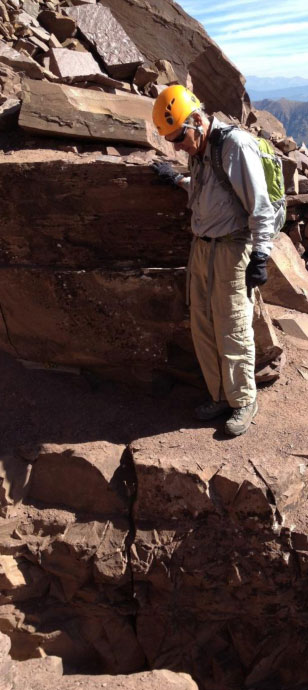
Rick contemplating the Leap of Faith.
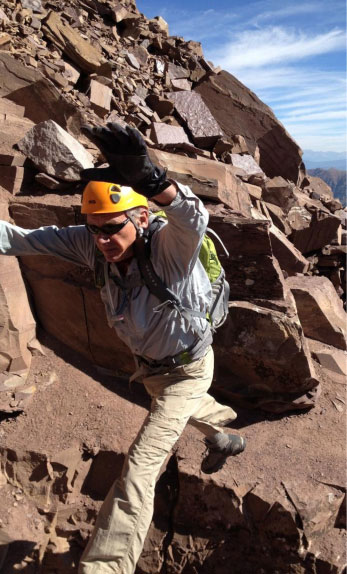
Up, up in the air junior birdman!
That was exciting, especially since it needed to be done again on the way back. Once we got done with the ledges, we still had 1000’ to go and that’s where the climbing got more serious.
Next up was the equally famous “green wall.” This is quite steep and route finding is critical – this wall is loose, varies from Class 3 to Class 4 pitches and is exposed. You won’t see any pictures of us climbing it – no chance I was going to take one hand off that wall to take a picture. Andy was busy scampering about to find the best route for me – I’m convinced he’s either got wings hidden under his T shirt or a secret anti-gravity belt. When you are up close and personal to this wall, you could be 15’ off and the next thing you know you’re on loose rock or some Class 5 thingy you don’t want to be on. With Andy managing the route, I actually had fun going up this – no stress about the weather and I knew the route would never get more difficult than Class 4.
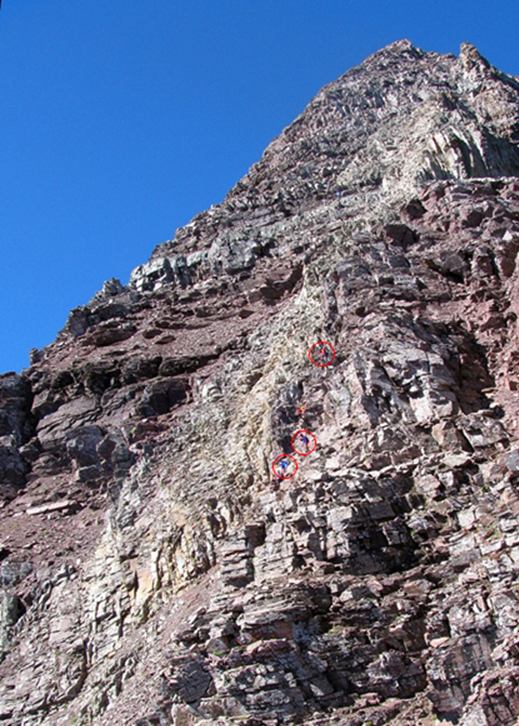
See the climbers in the middle of the green wall – gives you a sense of proportion.
The green wall goes up for about 700’ and then we cut out to the left. What’s left is about 250’, of which the first 200’ gets steeper yet, but still Class 3’s and 4’s. Part way up that pitch Andy turned to me and said: “you’re going to summit” which actually shocked me because I was in a total zone focused on one thing – each time I moved a hand or a foot I pre-tested for looseness – as long as I had solid rock, the steepness and exposure wasn’t bothering me at all.
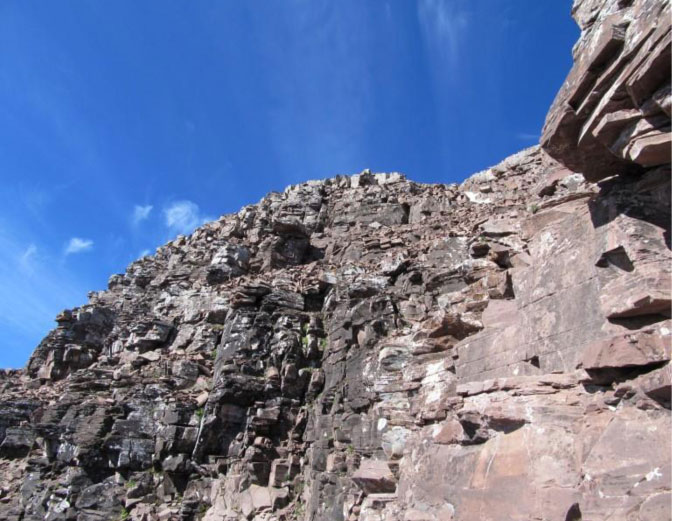
The final 250’ above the green wall. You got it – coming down was going to be no picnic.
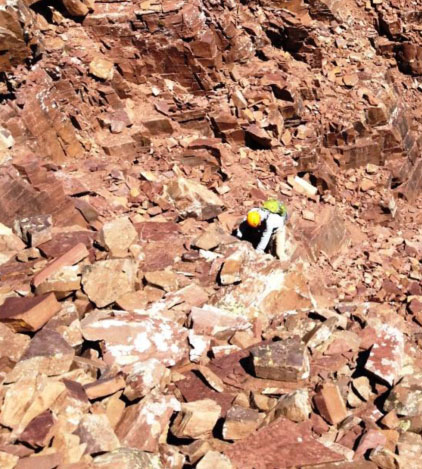
Rick coming up final 50’ to summit, where for the first time it actually got easier. You can tell from the picture how loose a lot of that rock is.
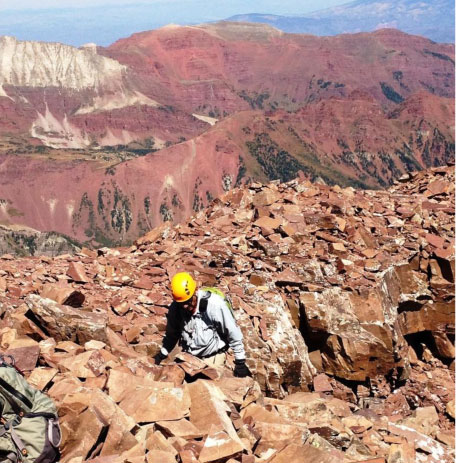
“Summiting Pyramid.” Never thought I’d be saying those words or writing this story – of course there’s still the down-climb, but let’s enjoy for a while.
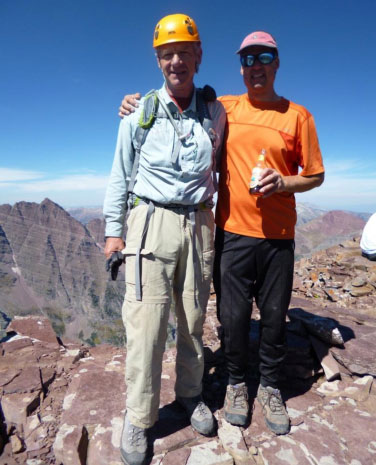
Summit Pyramid Peak, 14,018’
12:00 noon, 7 hours from Maroon Lake
Andy had three bottles of Newcastle beer in his pack – and they tasted gooood! That’s Maroon Bells in the background.
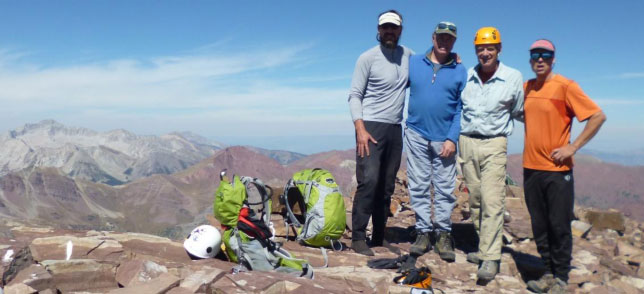
Left to right: Andrew; Jeff, Rick and Andy. Capitol Peak is in the background on the far left.
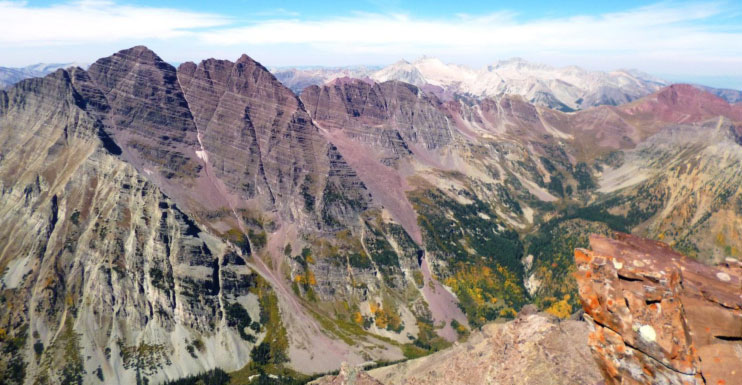
Views as far as the eye can see – no smoke! Maroon (left) and North Maroon (to its right); the whitish peak in the middle background is Snowmass Mountain and to its right is Capitol – all fourteeners.
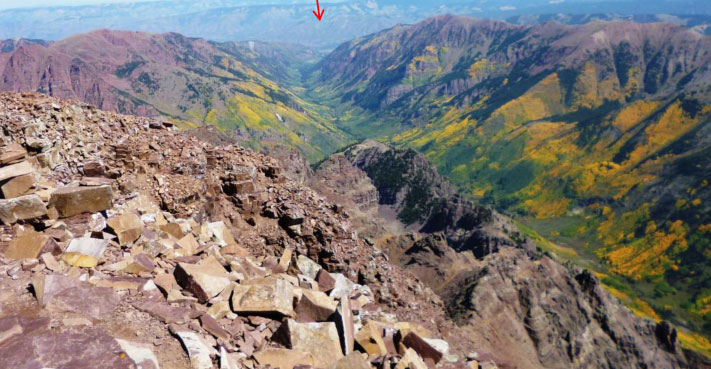
Looking all the way back to Starwood from the summit– our house is there somewhere!
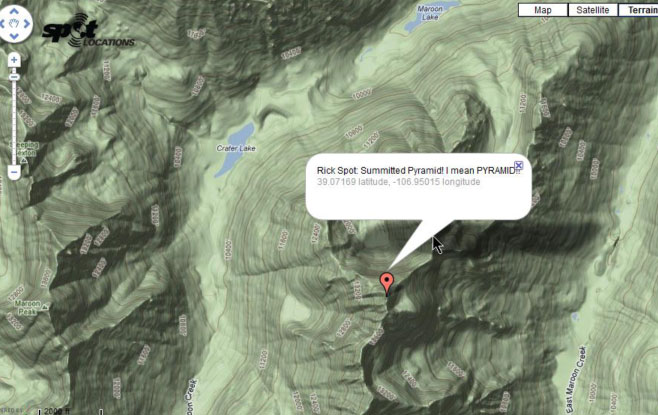

200 degree panorama shot with Capitol, Snowmass and the Bells on the right and a host of near and far fourteeners across the landscape. Andy identified about 15 of them, we could see all the way to the San Juan Mountain range!
Oh oh. We heard a helicopter buzzing around North Maroon – spotted him at about 13,000’. Andy says that’s not good, the tough part of that mountain is 700’ above that, could be a search and rescue. A little while later the chopper re-appeared – really not good.
Much later we learned from another climber coming up that indeed a solo climber fell to his death on North Maroon. When I got home, the on-line Aspen Times said:
Aspen Times 9/16/2012
ASPEN — A man fell to his death at North Maroon Peak on Saturday morning, the second life the notorious peak has claimed in a three-month span.
The climber, believed to be in his 30s, fell between 600 and 1000 feet, according to a Pitkin County Sheriff’s Office statement. Rescue personnel believe the climber had been wearing a helmet but not a harness.
At 9:20 a.m., officials were notified that a male climber had fallen in an area known as the “second gully.” Initial reports placed the climber at 300 feet from the peak’s summit at the time of the fall. Climbers unrelated to the incident were able to reach the fallen man and determined that he had died from injuries sustained in the fall.
At 12:10 p.m., a two-person Mountain Rescue Aspen team was placed in the field via helicopter. By 2 p.m., the body had been recovered and was later turned over to the Pitkin County Coroner’s Office. The Sheriff’s Office had no further information regarding the identity of climber.
Saturday’s death marks the second at North Maroon Peak this year. The peak is located 11 miles southwest of Aspen, at 14,014 feet.
Well while Pyramid is challenging, it’s not as hard as North Maroon … and I had Andy. So at about 12:45 pm we left that glorious peak to deal with safe, slow, deliberate down-climbing. Again, no photos, Andy was busy anti-grav-ing around and choosing between exposed Class 3 climbing vs. less exposed more difficult Class 4 and we chose the latter. The down-climb was much more difficult than ascending, but Andy was calling out footholds I couldn’t see on my own. He’d do the pitch first, I have no idea how, maybe he has some extra eyeballs in his feet.
When we got to the Class 4 pitches, there were times when I just couldn’t see what he was talking about. “Andy” I said. “I don’t see where to put the right foot.” He said, “Right here.” And he pointed to a 2” x 2” outcropping I could just about get my boot toe on. “That won’t hold me.” Says I. “Yes it will.” Says he.
Climbing Lesson
“Down-climb facing in to the mountain and always keep your arms out to push your upper body away from the mountain and stick your ass way out so your body pushes your feet into the mountain, then your toes will stick.” Oh yeah. I remember son Brett telling me that on Sunlight, but it’s not what your brain wants you to do, so you’ve got to force yourself into it.
It works – the feet stuck and down I went, safely down about 6 Class 4 pitches.
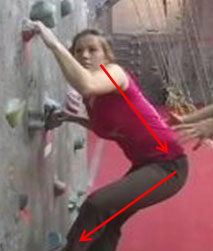
Stock photo with arrows added
Pitch by pitch, rock by rock, down we went to the top of the green wall. Then we were on that wall for I don’t know how long, but it didn’t matter. I was feeling good, the weather was amazing and we were taking no chances. After a long while we got to the ledges, past the narrow bits, jumped the Leap of Faith and made it to the saddle – past the really hard stuff but we still had 2800’ of down-climbing, the loose gully and the amphitheater to navigate.
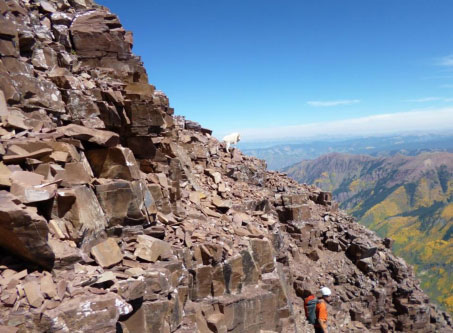
Andy and one of our goat buddies climbing down with us.
It was 3:30pm – and there was Andrew and Jeff waiting for us at the saddle. For how long? 45 minutes, but they looked comfortable and we all munched on something before heading down.
I suggested Andy give them the keys to his car so they could power down and Andy and I would go at my pace and I’d drive him home. It worked out great.
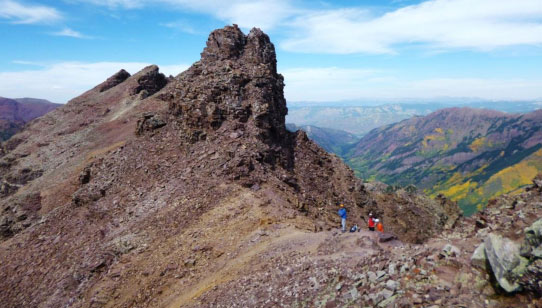
Jeff, Andrew and Andy at the saddle waiting for me. Loose gully is down to the left.
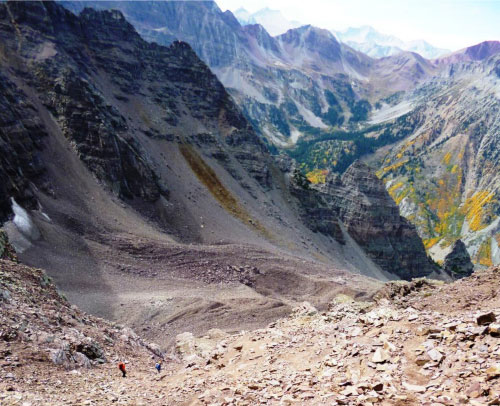
The guys are almost down the gully with the upper portion of the amazing amphitheater below
End of day coming down from Crater Lake. The late day sun is still on Pyramid Peak which is the left-most peak in the background.
We got back to the car at 6:45 pm, 13 hours and 45 minutes after the 5am start – Andy’s 14 hours was a remarkably good estimate!
This was a glorious day on a magnificent mountain under great conditions with a super friend.
